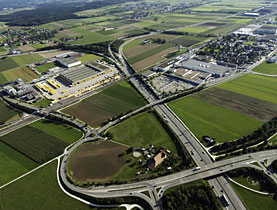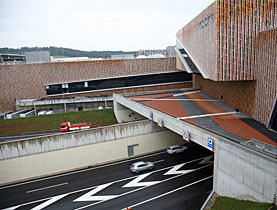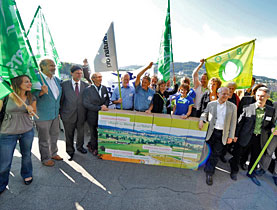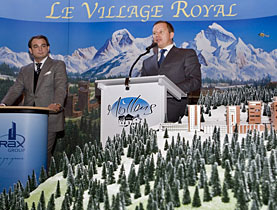Swiss countryside succumbs to urban sprawl

Switzerland has gone from a largely rural country to an urban one in just 70 years with developmental sprawl taking over pristine alpine regions, a study has found.
The Swiss National Science Foundation study released on Wednesday revealed that since 1935 urban development has claimed as much of the Swiss landscape as it did during the previous 2,000 years.
Geographers also found that the modern level of sprawl – inefficient, low-density development – in places like the Rhone Valley was proportionately identical to levels around Zurich.
“There really is no difference,” Christian Schwick, a geographer and co-author of the study, told swissinfo. “We in Switzerland think of the Alps as being untouched landscape, but we have seen this is not true.”
The foundation warns that in the absence of counter-measures, low-density development will continue in Switzerland, where 176 people on average occupy every square kilometre.
“Urban sprawl is tied to significant environmental, social and economic consequences,” the Science Foundation wrote, adding that it could lead to a loss of recreational and nature areas as well as higher costs for infrastructure and public services.
A new approach
The Zurich-based team, led by landscape fragmentation expert Jochen Jaeger, conducted the first national survey of urban sprawl taking into account development since 1935.
The study mapped development by tracking three factors of human settlement: population density, distances between buildings and the footprint of urban settlements on the landscape.
By comparing maps from 1935, 1960, 1980 and 2002, researchers were able to assign a coefficient to sprawl, with lower numbers signifying denser, more efficient communities.
In 1935 sprawl had a factor of 1.2. By 2002 it had leapt to nearly 2.6.
“That was fascinating to us,” Schwick said. “We all knew sprawl was happening, but the rate at which it was increasing was surprising.”
This three-pronged technique was new and afforded a clearer snapshot of development trends across Switzerland, Schwick said.
Spawning sprawl
Several factors are to blame for sprawl, including the rise of the car, high land prices in urban areas and the ability to build in places once ruled by nature.
Thanks to dams and snow barriers, the southern part of canton Ticino and the southwestern canton of Valais are being increasingly affected by development.
Once uninhabited areas in the Jura and the Alps have almost completely disappeared.
“It’s now possible to build where you couldn’t before,” Schwick said.
He also pointed to fewer people living in apartments than in past years. In 1935, a family of four would live in a two-bedroom apartment, whereas today just two people might live in that same space.
The decrease in population density, combined with easy transportation, means people can live and work in scattered areas. As a result, development has poured from city centres into the country along roads and railways.
According to the Federal Spatial Development Office, three quarters of Swiss people live in these urban tendrils, which can stretch far into the countryside.
“When we look back at 1935, cities had clear borders,” Schwick said. “You had the city and then free landscape with a few farm houses but that was all. Since then there is more of a blending.”
Moratorium on growth
The country’s 26 cantons and 2,700 local authorities have independent decision-making powers when it comes to planning matters for the most part.
Researchers said the study could be used to help propose benchmarks to limit urban sprawl by helping communities develop a system that gauges the efficiency of new development.
From an economic standpoint, tight communities are better since they require less public money for road maintenance, water services, and police and fire protection.
Unconsolidated development also leads to environmental issues as highways sever wildlife corridors and divide habitat.
In August 2008, a coalition of environmental organisations submitted more than 110,000 signatures to the government in support of a 20-year moratorium on new growth.
The cabinet is due to discuss the country’s spatial development laws next year, but a solution could prove difficult.
“People want to live in the country,” Schwick said. “But if you live in the green, the community pays.”
swissinfo, Tim Neville and Justin Häne
The project looked at how the development of roads and homes carved up the Swiss landscape between 1935 and 2002. It also projected development through 2050.
Calculating sprawl takes population changes into consideration. Switzerland’s population increased from about 4.2 million in 1935 to 7.2 million in 2002. But the amount of space one person occupied in 1935 roughly doubled by 2002.
The study examined maps of remaining, undeveloped land and the spatial arrangement of development. It also looked to pinpoint trends in future development.
The highest rates of sprawl were found in cantons Valais, Nidwalden, Basel, Solothurn, Ticino and Geneva.
Researchers believe the project can help communities make recommendations for controlling sprawl by creating appropriate development plans.
The study can also give indications about the dangers facing biodiversity as wildlife migration patterns and habitat battle highways and neighbourhoods.
Switzerland is the eighth most densely populated country in Europe.
The microstate of Malta, just below italy, is the most densely-populated. On average, 1,261 people live on each square kilometre there.
These countries (not including Monaco, Andorra, San Marino and Vatican City) round out the top ten in Europe:
2. The Netherlands (395)
3. Britain (246)
4. Germany (232)
5. Liechtenstein (216)
6. Italy (193)
7. Luxembourg (186)
8. Switzerland (176)
9. Czech Republic (132)
10. Denmark (127)

In compliance with the JTI standards
More: SWI swissinfo.ch certified by the Journalism Trust Initiative



You can find an overview of ongoing debates with our journalists here. Please join us!
If you want to start a conversation about a topic raised in this article or want to report factual errors, email us at english@swissinfo.ch.